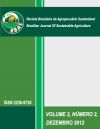USE OF COW URINE FOR TABLE BEET CULTIVATION
DOI:
https://doi.org/10.21206/rbas.v2i2.161Abstract
The cow's urine can be regarded as a by-product of the dairy activity and has been used successfully in some cultures. The work aimed to evaluate the effect of cow's urine on growth and production of table beetroot grown in soil with high fertility. The experiment was made up of 12 treatments, split-plots scheme, randomized block design, with four repetitions. On the plots were allocated the means of application of cow's urine (foliar and soil) and in split-plots, concentrations of solutions from cow's urine (0, 2, 4, 6, 8 and 10%). The following parameters were evaluated: the nitrogen state (SPAD); number of leaves; leaf area; fresh matter and dry matter of limbo, petiole and tuberous roots and absorbent; total soluble solids (Brix) and yield of commercial tuberous roots. There was no significant interaction between means x concentration application on the characteristics evaluated. Linear increments were observed of the urine concentrations to: leaf area, dry matter mass of limbo and fresh and dry materials of petiole. Application via soil compared to leaves applications, provided greater mass of dry matter in limbo, fresh and dry matter of petiole and dry absorbent roots. The SPAD index was not influenced by concentration or via application, however presented linear increment over the crop cycle. The results obtained show that the effect of cow's urine stimulating growth cannot be attributed solely to the supply of nutrients to the plants.Downloads
Downloads
Published
2012-12-01
How to Cite
Nelson Licínio Campos de Oliveira, Mário Puiatti, Aline da Silva Bhering, Paulo Roberto Cecon, & Geovani do Carmo Copati da Silva. (2012). USE OF COW URINE FOR TABLE BEET CULTIVATION. Brazilian Journal of Sustainable Agriculture, 2(2). https://doi.org/10.21206/rbas.v2i2.161
Issue
Section
Artigos
License
1. Proposta de Política para Periódicos de Acesso Livre
Autores que publicam nesta revista concordam com os seguintes termos:
Autores mantém os direitos autorais e concedem à revista o direito de primeira publicação, com o trabalho simultaneamente licenciado sob a Licença Creative Commons Attribution que permite o compartilhamento do trabalho com reconhecimento da autoria e publicação inicial nesta revista.











